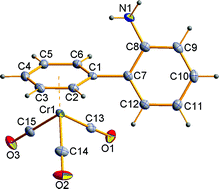Haptotropic rearrangement in tricarbonylchromium complexes of 2-aminobiphenyl and 4-aminobiphenyl†
Abstract
The para-aminobiphenyl compound [(η6-C6H5)(C6H4-4-NH2)]Cr(CO)3 (1) has an

* Corresponding authors
a
Department of Chemistry, University of Wisconsin – La Crosse, 1725 State Street, La Crosse, WI, USA
E-mail:
czerwins.curt@uwlax.edu
b Department, of Chemistry, University of Wisconsin – Madison, 1101 University Avenue, Madison, WI, USA
The para-aminobiphenyl compound [(η6-C6H5)(C6H4-4-NH2)]Cr(CO)3 (1) has an

 Please wait while we load your content...
Something went wrong. Try again?
Please wait while we load your content...
Something went wrong. Try again?
C. J. Czerwinski, I. A. Guzei, K. M. Riggle, J. R. Schroeder and L. C. Spencer, Dalton Trans., 2011, 40, 9439 DOI: 10.1039/C1DT10994D
To request permission to reproduce material from this article, please go to the Copyright Clearance Center request page.
If you are an author contributing to an RSC publication, you do not need to request permission provided correct acknowledgement is given.
If you are the author of this article, you do not need to request permission to reproduce figures and diagrams provided correct acknowledgement is given. If you want to reproduce the whole article in a third-party publication (excluding your thesis/dissertation for which permission is not required) please go to the Copyright Clearance Center request page.
Read more about how to correctly acknowledge RSC content.
 Fetching data from CrossRef.
Fetching data from CrossRef.
This may take some time to load.
Loading related content
